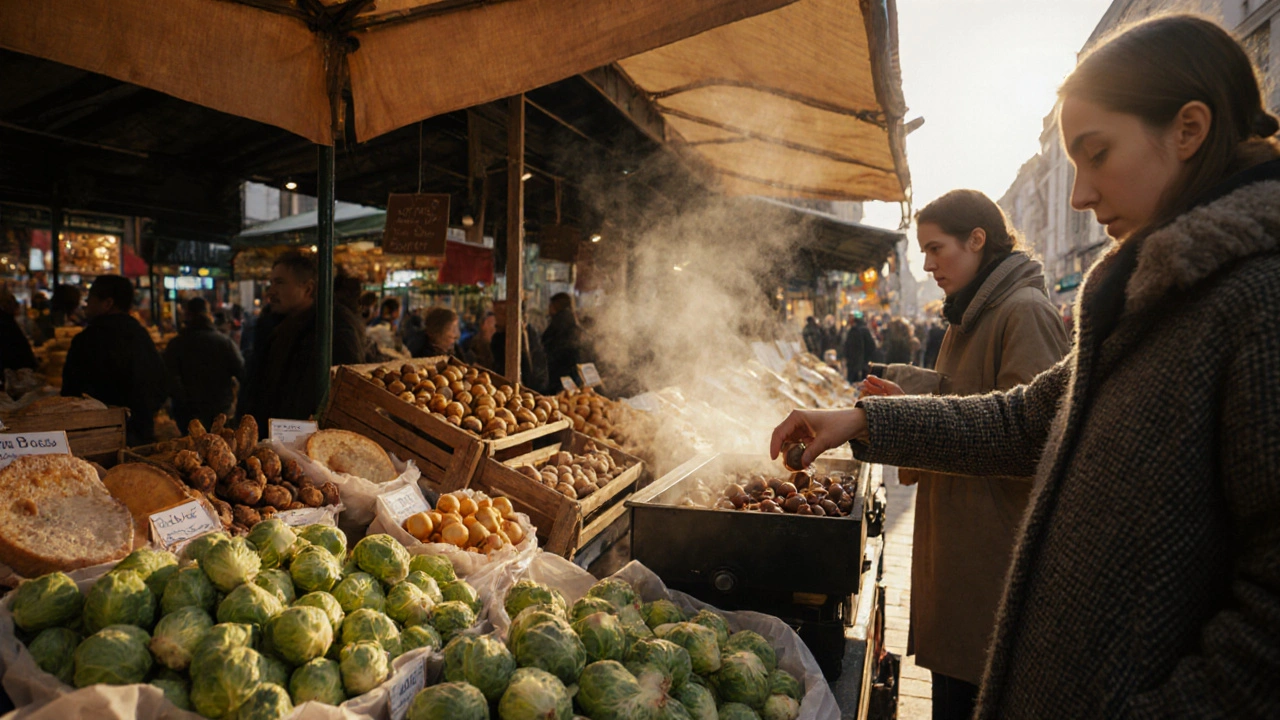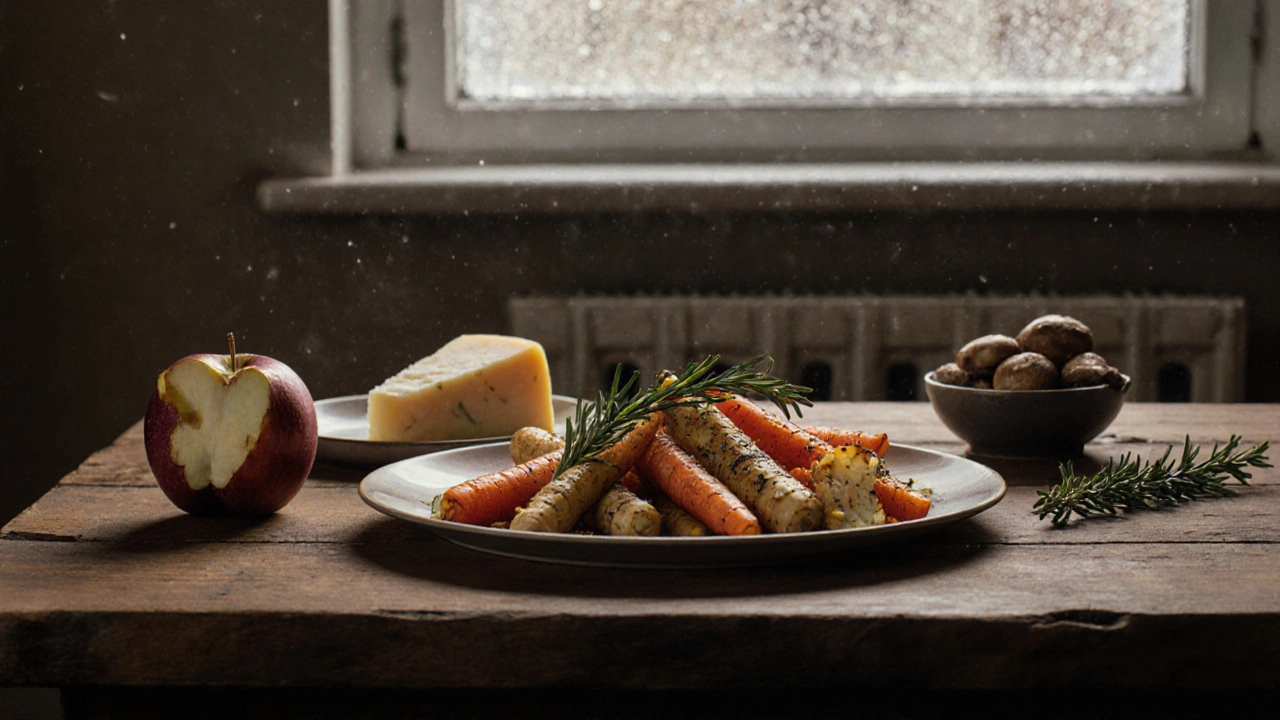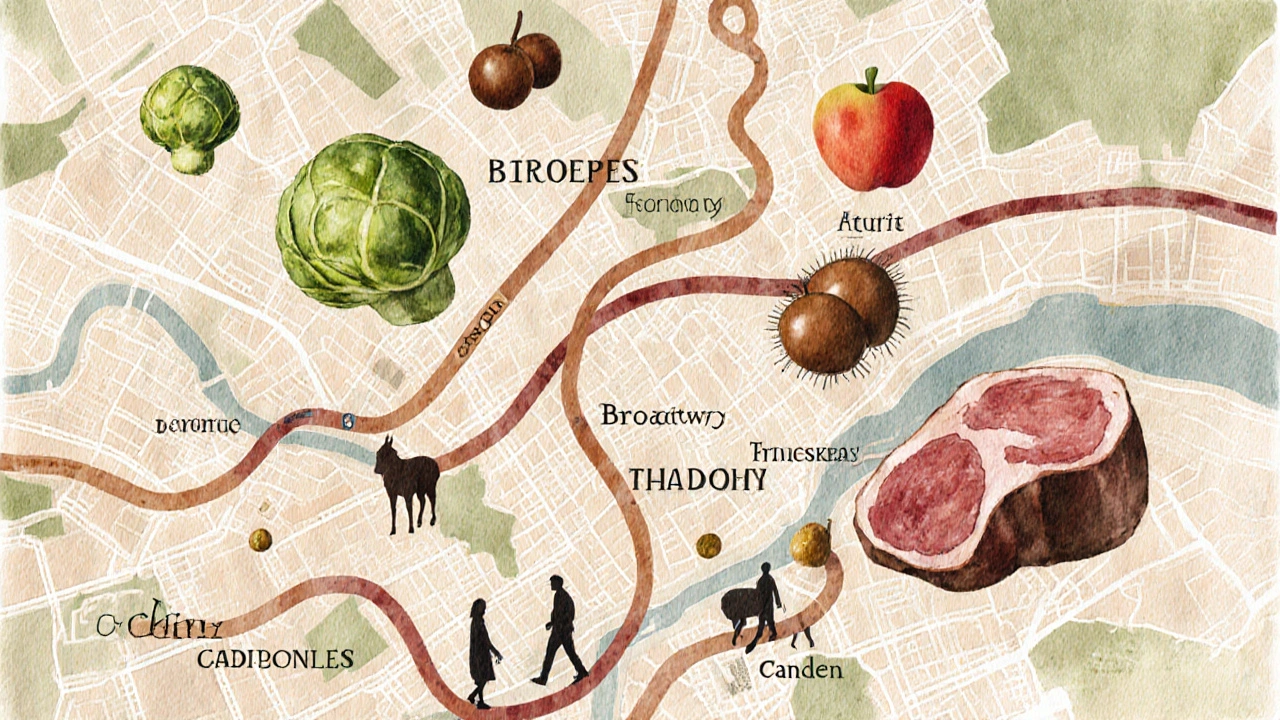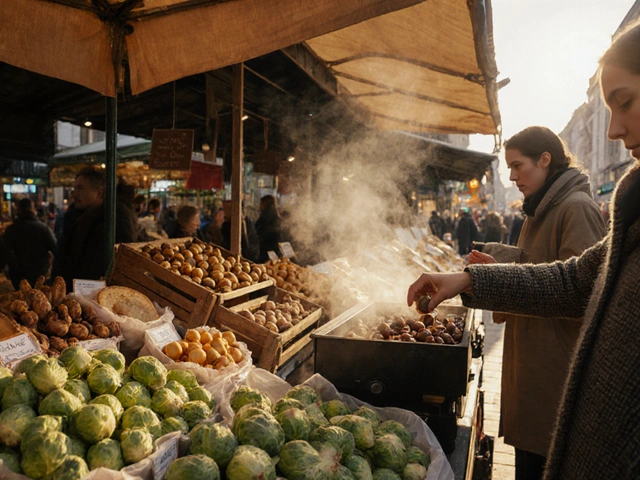
You know that feeling when you bite into a crisp, juicy apple and it tastes like autumn itself? That’s what seasonal eating in London is all about-food that doesn’t just fill you up, but connects you to the rhythm of the city and the land around it. Right now, as November rolls in, the markets are bursting with flavors you won’t find in supermarkets year-round. And if you’re wondering what’s actually worth eating right now, you’re not alone. Let’s cut through the noise and show you exactly what’s fresh, what’s local, and what you should be putting on your plate before winter fully sets in.
Why Seasonal Food Matters in London
It’s not just about taste-it’s about quality, price, and sustainability. When you eat seasonal food in London, you’re getting produce that was picked at its peak, traveled less than 50 miles, and didn’t need artificial ripening or plastic wrapping to survive a long journey. Think of it like this: a British Bramley apple harvested in October tastes brighter, tarter, and more satisfying than one shipped from New Zealand in July. The difference isn’t subtle. It’s the kind of thing you notice once you’ve tried both.
Local farmers markets across London-from Broadway Market in Hackney to Borough Market in Southwark-stock only what’s in season. That means less water waste, lower carbon emissions, and more money staying in the hands of small growers. And honestly? It just tastes better. You don’t need a foodie label to know when something’s fresh. Your tongue knows.
What’s in Season in London Right Now (November 2025)
Right now, London’s kitchens are humming with a handful of stars. Here’s what you should be looking for:
- Brussels sprouts - Yes, really. The frost has sweetened them. Look for tight, bright green heads at farmers markets. Roast them with chestnuts and a splash of balsamic, and you’ll forget you ever hated them.
- Root vegetables - Parsnips, carrots, turnips, and swedes are at their sweetest after a cold snap. They store well and turn into hearty stews, mash, or roasted sides with just butter, salt, and time.
- Chestnuts - Roasted chestnuts are a classic London street food, especially around Christmas markets. But don’t just buy them from a cart-try them in soups, stuffings, or even sweet puddings. Fresh chestnuts have a creamy, nutty depth you won’t find canned.
- Apples and pears - Varieties like Cox’s Orange Pippin, Bramley, and Conference are still hanging strong. Use them in tarts, crumbles, or just snack on them with cheddar. The tartness cuts through rich winter dishes perfectly.
- Game meats - Venison, pheasant, and rabbit are in season from October to February. Butcher shops like L. D. Wilson in Notting Hill or The Meat Lovers in Islington carry locally sourced cuts. Try venison sausages with red cabbage and mash-it’s the kind of meal that warms you from the inside out.
- Winter greens - Kale, cavolo nero, and spinach are still growing. They hold up in soups, stir-fries, or sautéed with garlic and olive oil. Don’t toss the stems-they’re edible and packed with fiber.
- Wild mushrooms - Cepes, chanterelles, and hedgehog mushrooms pop up after the first rains. Look for them at Borough Market or specialty grocers like Neal’s Yard Dairy. They’re pricey, but a little goes a long way in risottos or on toast with thyme.
Where to Find the Best Seasonal Food in London
Supermarkets have their place, but if you want the real deal, head to these spots:
- Borough Market - The granddaddy of London’s food markets. Come early on a Saturday and you’ll find stalls like Wright’s of Kent selling chestnut purée and Harper & Blohm with seasonal cheese and bread.
- Broadway Market - A hip, local favorite in Hackney. Check out Brothers of the Earth for organic root veg and Mr. Fogg’s for homemade pickles made with seasonal fruit.
- Camden Market - Not just for tourists. Head to the food hall on weekends for vendors like London Spice Co. selling seasonal spice blends and Roots & Shoots with fresh kale and beetroot juices.
- Local farm shops - Try Chilgrove Farm in Ealing or Walthamstow Farmers Market on Sundays. You’ll find eggs, honey, and preserves made from what’s just been picked.
- Independent butchers and greengrocers - Ask questions. A good butcher will tell you where the venison came from. A great greengrocer will let you taste a pear before you buy it.

How to Cook Seasonal London Food (Simple Ideas)
You don’t need a fancy recipe. Here’s how to make the most of what’s around:
- Roast root veg - Chop parsnips, carrots, and swedes into chunks. Toss with olive oil, rosemary, salt, and pepper. Roast at 200°C for 40 minutes. Add a splash of maple syrup in the last 10 minutes for caramelized sweetness.
- Make a chestnut and lentil stew - Sauté onions, garlic, and celery. Add brown lentils, vegetable stock, roasted chestnuts, and a bay leaf. Simmer for 30 minutes. Serve with crusty bread.
- Brussels sprouts with pancetta - Halve sprouts. Fry pancetta until crispy. Add sprouts and cook until tender. Finish with lemon zest and a drizzle of honey.
- Apple and cheddar tart - Thinly slice Cox’s apples. Layer over puff pastry with thick cheddar. Dot with butter. Bake until golden. Eat warm with a dollop of crème fraîche.
- Wild mushroom toast - Sauté mushrooms with garlic and thyme. Spread on sourdough. Top with a fried egg and a sprinkle of flaky salt.
What’s Out of Season (And Why to Skip It)
Just as important as knowing what’s in season is knowing what’s not. Right now, avoid these unless you’re okay with paying double for flavorless imports:
- Strawberries - Unless they’re from a heated greenhouse (and even then, they taste like cardboard), skip them. They’re not ripe here in November.
- Tomatoes - The ones in supermarkets now are grown in Spain or the Netherlands under lights. They lack acidity and juiciness. Wait until May.
- Avocados - They’re not grown in the UK. The ones you see are flown in, often overripe or bland. Try roasted beetroot or mashed white beans as a creamy alternative.
- Stone fruits - Peaches, plums, nectarines? They’re long gone until next summer. Stick to apples and pears.

Seasonal Food vs. Supermarket Food: A Quick Comparison
| Feature | Seasonal Food | Supermarket Food |
|---|---|---|
| Flavor | Intense, natural, ripe | Muted, often uniform |
| Price | Lower when in peak season | Higher due to import costs |
| Carbon footprint | Low-grown nearby | High-often shipped from abroad |
| Nutrition | Higher vitamin content | Often lost during transport |
| Supports local | Yes-farms and markets | No-corporate supply chains |
What to Do If You Can’t Find It
Not every neighborhood has a farmers market. Not every week is perfect. If you’re stuck with supermarket produce, here’s what to do:
- Look for the British Food label on packaging. It means it was grown or raised in the UK.
- Choose frozen vegetables. They’re often flash-frozen at peak ripeness and can be more nutritious than out-of-season fresh.
- Use herbs and spices to boost flavor. A pinch of smoked paprika or a dash of apple cider vinegar can make a bland dish feel alive.
- Join a veg box scheme. Companies like Riverford or Organic Box deliver seasonal produce weekly to your door.
Final Tip: Taste Before You Buy
At any market, if you’re unsure about a fruit or vegetable, ask to taste it. Most vendors will let you try a bite. If it’s not sweet, crisp, or flavorful, move on. That’s your signal that it’s not ready-or it’s not local. Trust your senses. They’re sharper than any food blog.
Seasonal eating isn’t a trend. It’s a return to how people ate for thousands of years. In London, it’s still alive-in the hands of farmers, bakers, butchers, and market stallholders who care about what they grow and sell. You don’t need to eat like a foodie to do it right. Just eat what’s here, now. And taste the difference.
What’s the best seasonal food to try in London this November?
Roasted Brussels sprouts with chestnuts and balsamic glaze is a standout. They’re sweetened by frost, packed with flavor, and a true taste of London’s autumn. Don’t skip the chestnuts either-they’re creamy, nutty, and sold fresh at Borough Market.
Where can I buy seasonal produce in London?
Borough Market, Broadway Market, and Walthamstow Farmers Market are top choices. For a quieter experience, check out local farm shops in Ealing, Islington, or Southwark. Look for stalls that say "British-grown" or ask the vendor where their produce comes from.
Are seasonal foods more expensive in London?
Not usually. When in season, local produce is often cheaper than imported goods because it doesn’t need long-distance transport or storage. A bag of carrots from a market stall costs less than the same bag in a supermarket, especially if they’re flown in from overseas.
Can I still eat seasonal food if I live in North London?
Absolutely. Markets like Camden and Crouch End Farmers Market offer seasonal goods. You can also sign up for a veg box delivery from Riverford or Organic Box-they deliver across all boroughs. Local butchers and greengrocers in your area often stock seasonal items too.
What’s the easiest seasonal dish to make at home?
Roast root vegetables. Chop carrots, parsnips, and swedes into chunks, toss with olive oil, salt, pepper, and rosemary. Roast at 200°C for 40 minutes. That’s it. Serve with grilled sausages or a fried egg. It’s simple, filling, and tastes like winter comfort.
Comments (8)
- Taranveer Dhiman
- November 11, 2025 AT 01:57 AM
OMG this post is literally a love letter to autumn 🍂🍎 I just had roasted Brussels sprouts with chestnuts and balsamic at Borough Market yesterday and I swear I cried a little. This is the kind of food that makes you feel like you’re part of something ancient and beautiful. Also, the fact that they still sell fresh chestnuts on street corners? Pure magic. 🥹✨
- Steven Williams
- November 12, 2025 AT 08:41 AM
Roast root veggies with rosemary is the easiest and most reliable winter dish. No fancy ingredients. Just chop, oil, salt, roast. Done. Works every time. Save your energy for the real stuff - like finding good venison.
- Danny Burkhart
- November 13, 2025 AT 11:41 AM
Okay but let’s be real - if you’re still eating supermarket tomatoes in November, you’re not just bad at cooking, you’re actively disrespecting the seasons. 🤦♂️ I saw someone buy a $4 plastic tub of ‘vine-ripened’ tomatoes the other day and I almost called the food police. They tasted like sadness wrapped in plastic. Please. Just wait. May isn’t that far away. And if you want umami? Try mushrooms. Or miso. Or literally anything else. 🙏
- Mike Gray
- November 15, 2025 AT 00:57 AM
You guys are doing great! Seriously. Eating seasonal food isn’t hard - it’s just about paying attention. I used to buy strawberries in winter too, until I tried a real one in July. It was like waking up from a nap. Now I just wait. And when the time comes? It’s worth it. You don’t need to be fancy. Just be patient. And taste. That’s it.
- Swapnil Dicholkar
- November 15, 2025 AT 20:11 PM
I moved to London from India last year and I didn’t know what to expect with the food. But this? This is beautiful. The way you talk about chestnuts and root veggies - it made me think of my grandma’s winter stews back home. I just made a parsnip and lentil soup last night with a bit of cumin and it felt like home. Thank you for reminding me that food connects us, no matter where we’re from. 🙏
- Nitz Shofner
- November 17, 2025 AT 09:48 AM
Why are you even listing Borough Market like it’s some sacred temple? It’s a tourist trap with overpriced cheese and people paying £8 for a single croissant. And don’t get me started on ‘fresh chestnuts’ - half of them are imported from France and roasted with industrial sugar syrup. You think you’re eating local? You’re eating marketing. Real seasonal food is at Walthamstow on a Tuesday morning when the vendors are still unpacking. Go there. Or don’t. But stop pretending you’re a food philosopher because you ate sprouts with balsamic.
- Naomi Dietrich
- November 19, 2025 AT 09:40 AM
Oh my god. I can’t believe someone actually wrote a whole post about how to roast vegetables and didn’t mention garlic butter. Are you serious? You’re telling people to roast parsnips with rosemary and olive oil but skipping the garlic butter? That’s culinary heresy. I’m not even mad - I’m disappointed. You didn’t even mention how to crisp the edges with a little butter baste halfway through. You’re not cooking. You’re just heating things up. 🤦♀️
- brandon garcia
- November 21, 2025 AT 05:52 AM
Y’ALL. I just got back from a 12-hour shift at the bakery and I’m still buzzing. I spent the whole morning shelling fresh chestnuts for our seasonal galette - you have NO IDEA how much better they are than canned. The smell alone? Like a warm hug from a forest. And when I roasted the sprouts with pancetta and honey? My coworkers cried. Not joking. One guy said it reminded him of his grandma’s kitchen in Scotland. That’s the power of real food. Don’t overthink it. Just get your hands dirty. Go to a market. Ask a vendor. Taste something you’ve never tried. That’s how you find joy. And yeah - you can do it from North London. I did. From a bus stop and a veg box. You got this. 💪🍂





